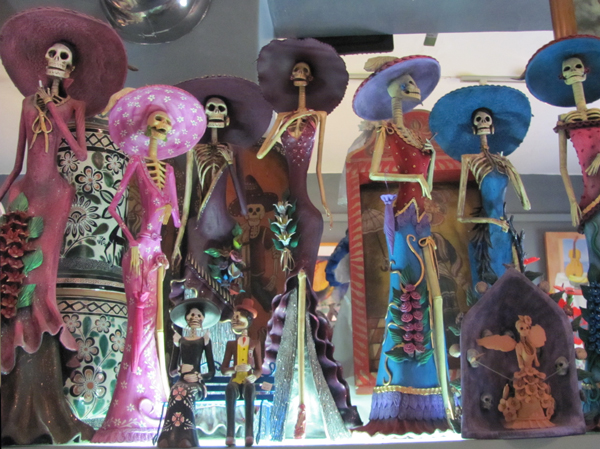It’s a Dead Man’s Party!

Come the beginning of November, Mexican families throw a feast and invite the dead over for dinner. Though Día de los Muertos (Day of the Dead) is often confused with Halloween due to the proximity in time, this holiday is not about ghouls and goblins, but instead honors the dead and welcomes their souls home as a blessing.
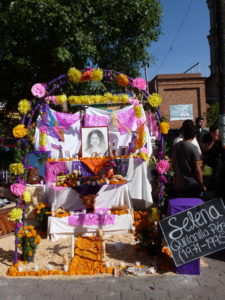 Altars and offerings are a way to remember family members who have passed into the afterlife, as well as celebrities, beloved to the Mexican population. In this culture, the lines between life and death are blurred and the acceptance of mortality becomes a liberation from fear. Indeed, life and death live on parallel planes in Mexico. This beautiful festival has a profound life lesson that transcends life itself.
Altars and offerings are a way to remember family members who have passed into the afterlife, as well as celebrities, beloved to the Mexican population. In this culture, the lines between life and death are blurred and the acceptance of mortality becomes a liberation from fear. Indeed, life and death live on parallel planes in Mexico. This beautiful festival has a profound life lesson that transcends life itself.
Celebrated in central and southern Mexico during the chilly days of November 1 & 2. It is believed that the gates of heaven are opened at midnight on October 31, and the spirits of all deceased children (angelitos) are allowed to reunite with their families for 24 hours. On November 2, the spirits of the adults come down to enjoy the festivities that are prepared for them.
In most villages, beautiful altars (ofrendas) are made in each home. They are decorated with candles, buckets of flowers (wild marigolds called cempasuchil & bright red cock’s combs) mounds of fruit, peanuts, plates of turkey mole, stacks of tortillas and big Day-of-the-Dead breads called pan de muerto. The altar needs to have lots of food, bottles of soda, hot cocoa and water for the weary spirits. Toys and candies are left for the angelitos, and on Nov. 2, cigarettes and shots of mezcal are offered to the adult spirits. Little folk art skeletons and sugar skulls, purchased at open-air markets, provide the final touches.
 Day of the Dead is a very expensive holiday for these self-sufficient, rural based, indigenous families. Many spend over two month’s income to honor their dead relatives. They believe that happy spirits will provide protection, good luck and wisdom to their families. Ofrenda building keeps the family close.
Day of the Dead is a very expensive holiday for these self-sufficient, rural based, indigenous families. Many spend over two month’s income to honor their dead relatives. They believe that happy spirits will provide protection, good luck and wisdom to their families. Ofrenda building keeps the family close.
On the afternoon of Nov. 2, the festivities are taken to the cemetery. People clean tombs, play cards, listen to the village band and reminisce about their loved ones. Tradition keeps the village close. Day of the Dead is becoming very popular in the U.S.~ perhaps because we don’t have a way to celebrate and honor our dead, or maybe it’s because of our fascination with it’s mysticism.
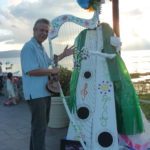
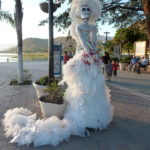 A very special time in Chapala is the bigger than life size Catrina’s all along the malecon (boardwalk). They are generally produced by local organizations, schools, and charities. Sometimes with a theme..The wedding Catrina to the left is made entirely from trash bags! A sight to behold!! And the streets along Francisco Madero are lined with alters celebrating the lives of loved ones and Mexican dignities.
A very special time in Chapala is the bigger than life size Catrina’s all along the malecon (boardwalk). They are generally produced by local organizations, schools, and charities. Sometimes with a theme..The wedding Catrina to the left is made entirely from trash bags! A sight to behold!! And the streets along Francisco Madero are lined with alters celebrating the lives of loved ones and Mexican dignities.
Always remember:
Treat the spirits with respect and speak well of them always. While it’s a celebration, it’s not Halloween and it’s a festival about respect.
 Paint your face. Join in the festivities and surrender your face to be painted by one of the local artists.
Paint your face. Join in the festivities and surrender your face to be painted by one of the local artists.
Tour a graveyard. Altars are an important part of the festivities and cemetery tours are a good way to visit the atmospheric altars. However, be very respectful of family celebrations. Ask to take photos and ask questions.
The best collection of Day of the Dead memorabilia can be found at Diane Pearl Collections, the premiere gift shop in all of Lakeside!
Her collection of beautiful Catrinas are amazing and must be seen to be beleived!
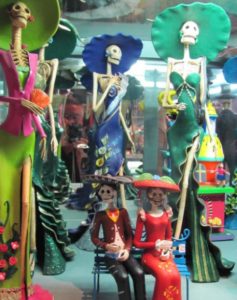 Did you know?
Did you know?
Catrinas are made all over Mexico. They were originally inspired by the famous “La Calavera Catrina” etching by Jose Guadalupe Posada, which depicted a very well dressed woman at the turn of the century as a skeleton. However, the Catrina was made popular by a Diego Rivera mural.
Since then, Catrina has come to symbolize not only El Día de los Muertos but also the Mexican willingness to laugh at death itself.
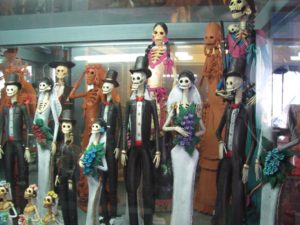 We have an amazing and, we think, the most complete and impressive collection of Catrinas in all of Mexico! From 4 inches to 4 feet in every imaginable attire.
We have an amazing and, we think, the most complete and impressive collection of Catrinas in all of Mexico! From 4 inches to 4 feet in every imaginable attire.
From funny to scary, ugly to beautiful, large and small alike, perusing our huge selection is an experience all its own. Ask any of our staff to get one out for you and tell you about its meaning and about the artist who created it.
